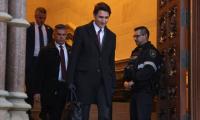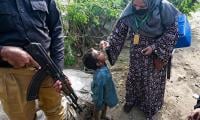ISLAMABAD: Eleven days after the general elections, the battle lines are now clearly drawn for a face-off inside and outside of the Parliament with opposition alliance vowing to give a tough time to the upcoming Pakistan Tehreek-e-Insaf (PTI) led multiparty coalition government.
The leading force of the incoming regime has welcomed the opposition grouping’s pledge to focus its activities within the Parliament and to not walk away from the premier democratic institution once called the political Kaaba by PTI Vice Chairman Shah Mehmood Qureshi.
The opposition’s positive announcement may have come as a surprise, against its expectations, to the PTI, which had differently performed this role by confining its lingering protest against the outgoing government outside of the Parliament throughout its five-year tenure. It might have anticipated the same devastating conduct from its archrivals.
As new political and parliamentary alignments are final and conclusive, both sides are engaged in firming up their strategies to take on each other. The parties and groups, which have stood with the next government, are now known, and so are the political forces, backing the opposition alliance.
The opposition’s scheme is loud and clear – to agitate at every forum. The challenge is for the next government how to run the National Assembly smoothly in the presence of a huge belligerent opposition, which is badly hurt by the deeply flawed general elections. Considering the number game, the opposition is likely to be on the offensive while the government will be on the defensive in an attempt to maintain peace and calm.
On the opposition’s side are the Pakistan Muslim League-Nawaz (PML-N), Pakistan People’s Party (PPP), religious parties’ cluster, Muttahida Majlis-e-Amal (MMA), and Awami National Party (ANP). They are in majority in the Senate to block any government-sponsored lawmaking bid and impose its own legislative business, but are in minority in the National Assembly with a small margin.
On the other side are teamed up a number of small parties to propel the PTI into power at the federal level. Figuring among are the Muttahida Qaumi Movement-Pakistan (MQM-P), PML-Q, Grand Democratic Alliance (DGA), Balochistan Awami Party (BAP), Balochistan National Party-Mengal (BNM-M) and Ahle Sunnat Wul Jamaat apart from almost all independent winners with some of them having formally joined the PTI and others being insistent on keeping their independent identity intact.
From the government side, the main onus and responsibility to counter the unrelenting onslaught from the behemoth opposition collection will be on the PTI’s shoulders as the assistance of its junior partners is unexpected to be meaningful and weighty. What is more, the extent of helping hand from the smaller coalition partners will depend on the quantum of their share in the federal cabinet.
It is believed that Imran Khan will have to give at least half a dozen federal ministries to his alliance associates. While accommodating them, he will need to give a substantial representation to his own party that is coming to power for the first time at the central level. Not only a predominant majority of key PTI leaders, who have been surrounding Imran Khan, but also its several federal legislators are impatiently aspiring for cabinet posts.
As usual more aggression is likely to be witnessed from the opposition combination particularly the PML-N, PPP and MMA, which have in their folds towering figures with rich experience of working in the opposition.
They had gone through the mill and faced worst torture and victimisation during military rules of Pervez Musharraf and Ziaul Haq. A number of PML-N stalwarts had a nightmarish time during Musharraf’s martial law while several PPP leaders received harshest treatment during Ziaul Haq’s time. Doing opposition is not something new for them.
However, for the PTI it is the first experience and experiment to run the federal government. A majority of its senior leaders will be totally raw hands in the administration. Imran Khan too has no skill and knowledge of the statecraft as he has never held any government office. In the PTI lot, Shah Mehmood Qureshi and Pervez Khattak are old hands which have had stints in governments. Many others including Asad Umar, who is being given the most important portfolio of finance, will be new in running key ministries.
“As opposition, we will strictly adhere to the ‘high values and norms’ set by the PTI over the past five years,” prominent PML-N leader Ahsan Iqbal has said sardonically.
However, the traditions and values introduced by the PTI are not enviable or kosher in any democratic polity. If the opposition alliance sticks to even a part of these standards, Pakistan is going to have immense chaos and anarchy. The PTI was just one principal political party that resorted to unprecedented agitation while now there are three most powerful entities – PML-N, PPP and MMA – which have the capacity to mobilise thousands of activists for any confrontation.
However, a host of opposition leaders have declared more than once that they will not do what the PTI had done - sit-ins, lockdowns, public torching of utility bills, civil disobedience movement, attacks on the Parliament building, Prime Minister’s House, PTV Headquarters and other key installations and beating of policemen – as they want to set healthy traditions even in their protests.
The very nomenclature given to the opposition bunch, Pakistan Alliance for Free and Fair Elections (PAFFE), puts forth the objective it is poised to achieve while highlighting and keeping its focus on the controversial nature of the July 25 polls.
For the moment, the PAFFE doesn’t plan any street protests but next week it will hold at least six demonstrations before the offices of the Election Commission of Pakistan (ECP) in Islamabad and provincial headquarters to highlight massive rigging. It will definitely create powerful scenes during Imran Khan’s election as prime minister and the subsequent vote of confidence, unmasking the shape of things to come in the National Assembly.
Protest is being led by religious scholars who have demanded immediate reopening and securing of roads
Dr Bhutta’s groundbreaking research and leadership improved lives of millions
Two FIA officers stationed at Faisalabad airport were also arrested for negligence during duty
Brand first became popular among feudal elites for its reliability in rural and mountain regions







